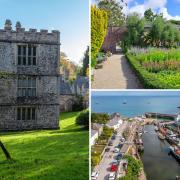Glendurgan in Cornwall is one of the UK's best-known gardens

is one of the UK's best-known gardens and is anything but traditional discovers LOUISE DANKS...
There are many beautiful gardens around the village of Mawnan Smith, such as Trebah, Carwinnion and Penjerrick, but Glendurgan is a garden that has an exceptionally strong identity.
Unusual and quirky plants pepper this garden. Its design includes heathers, agaves that grow out of open-lawn areas and form a relaxed and interesting feature, as well as a number of butia palms. Perhaps not the most obvious choices, but that is exactly the reason why here they fit with a flair all of their own.

Interrupting his work with a chainsaw and chipper, Garden Manager John Lanyon (in his own words a head-gardener-in-disguise) explains: 'Cornish gardens want to misbehave, so you have to get out there and garden'.
Glendurgan is one of the great valley gardens and its wooded slopes lead down to a pretty cove close to the village of Durgan on the Helford Passage; not too far away is the Fal Estuary, a deep-water harbour. This gave founder Alfred Fox the perfect opportunity to import new and exotic plants for his garden, specimens previously unseen even in the horticulturally rich county of Cornwall. The garden boasts many original plantings to this day, including two huge Liriodendron tulipifera, the tulip tree planted by Alfred Fox himself.
The 1820s and 1830s saw Alfred Fox design and tame this wooded valley and turn it into a garden enjoyed by so many today. John and his team are working hard to re-establish an orchard in the Pony Field, which will consist of local apple varieties, pears and plums; but also, in true Glendurgan style, grapefruit, pomegranate, lemons, kiwi and an olive grove will grow alongside the traditional.

The romanticism of a Cornish valley garden leading down to the sea is certainly not lost on the 70,000 visitors Glendurgan sees each year. This nearly 40-acre garden described as a garden with wavy edges is difficult to define by size or style because of its individuality. Even John has trouble describing it!
Plants are given the space and respect in which to thrive and their differing needs catered for. It is a garden in which even a fallen tree is seen as an opportunity and the team who work here have a real love for its heritage and a passion for developing its exciting future. John explains the emphasis on getting everything just right. Taking the time to find exactly the right plant for the right place is so important and its what Glendurgan is all about. With its sheltered location, it would be easy for the garden here at Glendurgan to rely on its stunning views alone but the gardeners and owners, past and present, have ensured that the garden is planned and planted to its full potential.

The gardens future is being insured an in-depth plant database has recently been completed at Glendurgan, recording each plants detail. In time all National Trust gardens will have a similar record of their plants. This information will eventually be available to visitors, other gardens and research organisations all over the world. Each garden has its own personalised Conservation Plan that details the history, character, garden elements and an individually tailored plan for the future.
Many Cornish spring gardens have a fair number of camellias, rhododendrons, azaleas and magnolias.Surprisingly, Glendurgan's collection withstood the frost and snow experienced early this year. A handful of these plants are rare in cultivation, such as the Magnolia sargentiana robusta Alba.
The changing carpets of wildflowers in Glendurgan's open glades are the perfect foil to the spectacular trees and shrubs that tower above. They continue the colour into the summer. Primroses and violets are followed in quick succession by bluebells and then aquilegias. John is keen to keep developing this feature of the garden and has plans to extend the flowering season of the wildflower banks well into the summer.
Glendurgan is a garden in which even a fallan tree is seen as an opportunity and its team has a love for its heritage and a passion for developing its exciting future

The Cherry Orchard is full of mature magnolias. Within the confines of the steep-sided valley, visitors are surrounded by the essence of a Cornish spring. The Laurel Maze is a hit with visitors and a great way to encourage younger ones to find their green fingers. Although an original feature of the garden planted in 1833, it underwent restoration in the early 1990s but still contains the original plants.
Gardens within gardens add to the overall interest here. Holy Corner illustrates the symbolism of plants in the Bible: you'll find a yew tree, Ailanthus altissima (the tree of heaven), an olive tree and a Cercis siliquastrum, commonly known as the Judas tree, a pretty tree with generous, heart-shaped leaves, gorgeous autumn colour and a mass of delicate pink flowers that bloom, unusually, on the bark of the tree.
The Tropical Garden shows just what exotic and tender plants can be grown. Bananas and tree ferns create a tapestry of texture with a large tetrapanax towering overhead and the glaucous Melianthus major growing in a swathe at its feet. Walking down the valley though a grove of Gunnera manicata, with its prehistoric-looking giant rhubarb leaves towering overhead, adds drama. A common mistake made by many gardeners who fall in love with this architectural beauty is to fail to give it the space or moisture it craves.
A special treat when visiting here, if another were needed, is the beach at the foot of the valley a chance to recharge your batteries ready for the stroll back. Glendurgan makes no apology for being a fabulous, shining example of a Cornish spring garden, but it is more than that: along with its character, it has magnetism and is widely valued and respected.

The garden is open from February half-term until October and is closed on Sundays and Mondays.



























